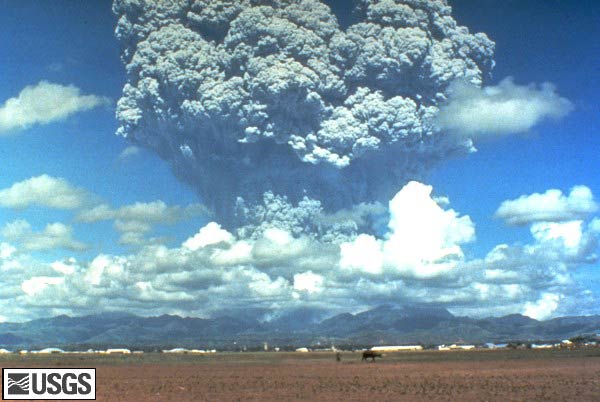Super Volcano Will Challenge Civilization, Geologists Warn

The eruption of a super volcano "sooner or later" will chill the planet and threaten human civilization, British scientists warned Tuesday.
And now the bad news: There's not much anyone can do about it.
Several volcanoes around the world are capable of gigantic eruptions unlike anything witnessed in recorded history, based on geologic evidence of past events, the scientists said. Such eruptions would dwarf those of Mount St. Helens, Krakatoa, Pinatubo and anything else going back dozens of millennia.
"Super-eruptions are up to hundreds of times larger than these," said Stephen Self of the United Kingdom's (U.K.) Open University.
"An area the size of North America can be devastated, and pronounced deterioration of global climate would be expected for a few years following the eruption," Self said. "They could result in the devastation of world agriculture, severe disruption of food supplies, and mass starvation. These effects could be sufficiently severe to threaten the fabric of civilization."
Self and his colleagues at the Geological Society of London presented their report to the U.K. Government's Natural Hazard Working Group.
"Although very rare these events are inevitable, and at some point in the future humans will be faced with dealing with and surviving a super eruption," Stephen Sparks of the University of Bristol told LiveScience in advance of Tuesday's announcement.
Get the world’s most fascinating discoveries delivered straight to your inbox.
Supporting evidence
The warning is not new. Geologists in the United States detailed a similar scenario in 2001, when they found evidence suggesting volcanic activity in Yellowstone National Park will eventually lead to a colossal eruption. Half the United States will be covered in ash up to 3 feet (1 meter) deep, according to a study published in the journal Earth and Planetary Science Letters.
Explosions of this magnitude "happen about every 600,000 years at Yellowstone," says Chuck Wicks of the U.S. Geological Survey, who has studied the possibilities in separate work. "And it's been about 620,000 years since the last super explosive eruption there."
Past volcanic catastrophes at Yellowstone and elsewhere remain evident as giant collapsed basins called calderas.
A super eruption is a scaled up version of a typical volcanic outburst, Sparks explained. Each is caused by a rising and growing chamber of hot molten rock known as magma.
"In super eruptions the magma chamber is huge," Sparks said. The eruption is rapid, occurring in a matter of days. "When the magma erupts the overlying rocks collapse into the chamber, which has reduced its pressure due to the eruption. The collapse forms the huge crater."
The eruption pumps dust and chemicals into the atmosphere for years, screening the Sun and cooling the planet. Earth is plunged into a perpetual winter, some models predict, causing plant and animal species disappear forever.
"The whole of a continent might be covered by ash, which might take many years -- possibly decades -- to erode away and for vegetation to recover," Sparks said.
Yellowstone may be winding down geologically, experts say. But they believe it harbors at least one final punch. Globally, there are still plenty of possibilities for super volcano eruptions, even as Earth quiets down over the long haul of its 4.5-billion-year existence.
"The Earth is of course losing energy, but at a very slow rate, and the effects are only really noticeable over billions rather than millions of years," Sparks said.
Human impact
The odds of a globally destructive volcano explosion in any given century are extremely low, and no scientist can say when the next one will occur. But the chances are five to 10 times greater than a globally destructive asteroid impact, according to the new British report.
The next super eruption, whenever it occurs, might not be the first one humans have dealt with.
About 74,000 years ago, in what is now Sumatra, a volcano called Toba blew with a force estimated at 10,000 times that of Mount St. Helens. Ash darkened the sky all around the planet. Temperatures plummeted by up to 21 degrees at higher latitudes, according to research by Michael Rampino, a biologist and geologist at New York University.
Rampino has estimated three-quarters of the plant species in the Northern Hemisphere perished.
Stanley Ambrose, an anthropologist at the University of Illinois, suggested in 1998 that Rampino's work might explain a curious bottleneck in human evolution: The blueprints of life for all humans -- DNA -- are remarkably similar given that our species branched off from the rest of the primate family tree a few million years ago.
Ambrose has said early humans were perhaps pushed to the edge of extinction after the Toba eruption -- around the same time folks got serious about art and tool making. Perhaps only a few thousand survived. Humans today would all be descended from these few, and in terms of the genetic code, not a whole lot would change in 74,000 years.
Sitting ducks
Based on the latest evidence, eruptions the size of the giant Yellowstone and Toba events occur at least every 100,000 years, Sparks said, "and it could be as high as every 50,000 years. There are smaller but nevertheless huge eruptions which would have continental to global consequences every 5,000 years or so."
Unlike other threats to mankind -- asteroids, nuclear attacks and global warming to name a few -- there's little to be done about a super volcano.
"While it may in future be possible to deflect asteroids or somehow avoid their impact, even science fiction cannot produce a credible mechanism for averting a super eruption," the new report states. "No strategies can be envisaged for reducing the power of major volcanic eruptions."
The Geological Society of London has issued similar warnings going back to 2000. The scientists this week called for more funding to investigate further the history of super eruptions and their likely effects on the planet and on modern society.
"Sooner or later a super eruption will happen on Earth and this issue also demands serious attention," the report concludes.
Robert is an independent health and science journalist and writer based in Phoenix, Arizona. He is a former editor-in-chief of Live Science with over 20 years of experience as a reporter and editor. He has worked on websites such as Space.com and Tom's Guide, and is a contributor on Medium, covering how we age and how to optimize the mind and body through time. He has a journalism degree from Humboldt State University in California.

